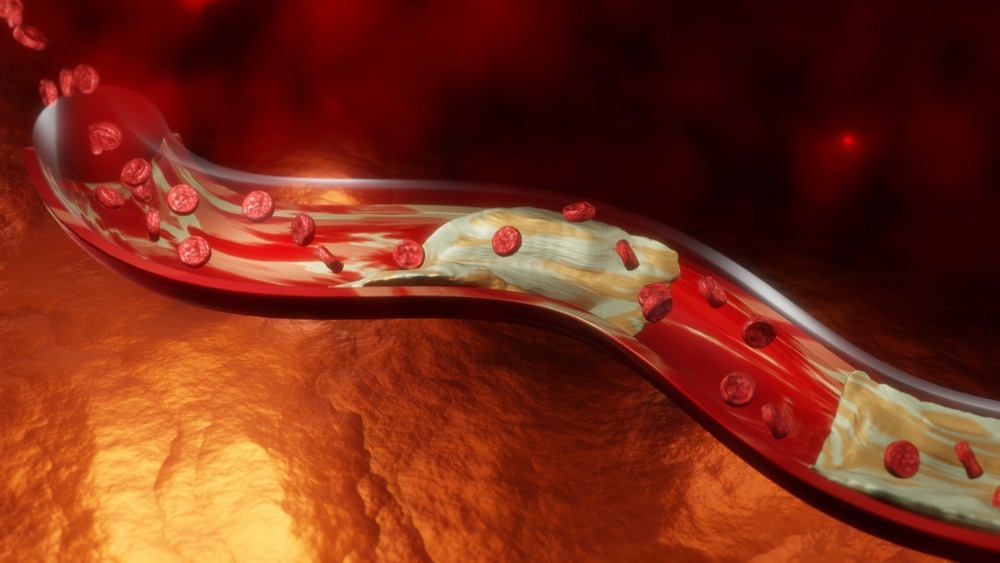Scientists have recently detected cholesterol using a novel biosensor based on TiO2 nanotube structures (TNTs) on a Ti6Al4V thin plate working electrode. This study has been published as a pre-proof in Materials Today: Proceedings.

Study: Fabrication of TiO2 nanotubes on Ti6Al4V thin plate for non-enzymatic cholesterol biosensor. Image Credit: Anshuman Rath/Shutterstock.com
What is Cholesterol?
Cholesterol is a fat-like substance detected in most living cells. It is predominantly present in the blood, nerve cells, and bile. Cholesterol is essential for the synthesis of steroids, bile acids, and vitamin D.
It is important to detect and estimate cholesterol levels in the blood as it helps evaluate an individual’s health condition. An elevated level of cholesterol (hypercholesteremia) causes high blood pressure, heart disease, obesity, and peripheral artery disease. Hence, it is important to regularly monitor cholesterol levels, which could lower the risk of the above-stated diseases.
Biosensors for the Detection of Biological Samples
Although spectrophotometric and colorimetric approaches are used to detect cholesterol, these methods are expensive, difficult, and involve the use of chemicals that promote unstable reactions. To address this, researchers have developed electrochemical cholesterol sensors, such as amperometric biosensors. This biosensor is user-friendly and can measure cholesterol instantaneously.
Even though enzymatic biosensors are employed to measure cholesterol levels due to their high sensitivity, these are easily affected by temperature, acidic/alkaline medium, and humidity. These conditions minimize the longevity of the enzymatic biosensor due to the reduced stability and reproducibility. To overcome these drawbacks, researchers developed non-enzymatic cholesterol sensors using metal oxide materials. These biosensors have shown promising cholesterol detection ability.
Recently, scientists have been using titanium nanostructures, such as titanium nanofibers, nanotubes, nanoparticles, and nanoneedles, to develop biological sensors. The key advantages of this material are its bioactivity, corrosion resistance, non-toxicity, simplicity, reproducibility, porosity, strong reversibility, electrochemical durability, and quick responsiveness.
TNT has been regarded to be a promising analyte substrate due to its many unique properties, including a large surface area, extraordinary charge carrier behavior, and a considerable number of reaction sites. Previous studies have shown that the anatase phase of TiO2 remains stable during the detection of cholesterol molecules via electrochemical techniques.
A Non-Enzymatic Cholesterol Biosensor based on TiO2 Nanotube Structures - A New Study
In a new study, researchers have synthesized TNTs on a Ti6Al4V thin plate, with and without annealing. They used various techniques, such as X-ray diffraction (XRD), Scanning Electron Microscope (SEM), and Cyclic voltammetry (CV), to characterize the newly developed TNTs on the Ti6Al4V thin plate.
The XRD pattern of a thin plate of Ti alloy exhibited diffraction peaks, which was analogous to the hexagonal phase of Ti. Scientists also reported that the XRD pattern of TNT nanostructure, post-annealing at 450oC for 2 hours, exhibited the greater crystalline nature of the nanotube than those that were not subjected to heat treatment of Ti6AL4V thin plate.
In this study, researchers created the working electrode to specifically sense cholesterol using the anodization route (20 V for 3 hours). SEM analysis revealed a uniform and smooth configuration of TNT nanostructure, whose diameter and wall thickness was measured to be 60-70 nm and 8 -12 nm, respectively.
Researchers determined the electrochemical property of the working electrode using CV in NaOH solution and the scan rate was kept at 50 mV/s. The CV curves of the TNT electrodes revealed similar oxidation and reduction peak potentials, with and without annealing; however, the peak intensity varied. In this study, researchers stated that annealing-oriented TNT electrodes were immersed in a 0.1 M NaOH solution to detect cholesterol molecules.
The chronoamperometry calibration curve showed a linear relationship between cholesterol concentration and current. The linearity was observed up to 15 mM of cholesterol; however, adding more cholesterol to the electrochemical solution, a change in pattern. The authors reported that the fabricated electrode revealed a wide linear range up to 15 mM, with a low detection limit (0.12 lM). Additionally, the fabricated electrode showed a quick response time of 17 seconds.
Conclusion
In this study, researchers have successfully detected cholesterol using a non-enzymatic method. They created non-crystalline and crystalline TNTs on a Ti6Al4V thin plate working electrode for the detection process. The authors stated that compared to the electrode with no annealing, the electrochemical performance of the annealed TNT electrode exhibited superior sensitivity.
The newly fabricated non-enzymatic cholesterol biosensor showed great electrochemical properties, which could aid in being used for continuous monitoring of cholesterol for healthcare applications. As the anatase phase of TiO2 nanotubes exhibited great stability and was less affected by alkaline/acidic media, it could be used for the development of point-of-care testing of total cholesterol at a low cost.
Reference
Kumar, B. et al. (2022) Fabrication of TiO2 nanotubes on Ti6Al4V thin plate for non-enzymatic cholesterol biosensor. Materials Today: Proceedings. https://doi.org/10.1016/j.matpr.2022.06.165
Disclaimer: The views expressed here are those of the author expressed in their private capacity and do not necessarily represent the views of AZoM.com Limited T/A AZoNetwork the owner and operator of this website. This disclaimer forms part of the Terms and conditions of use of this website.